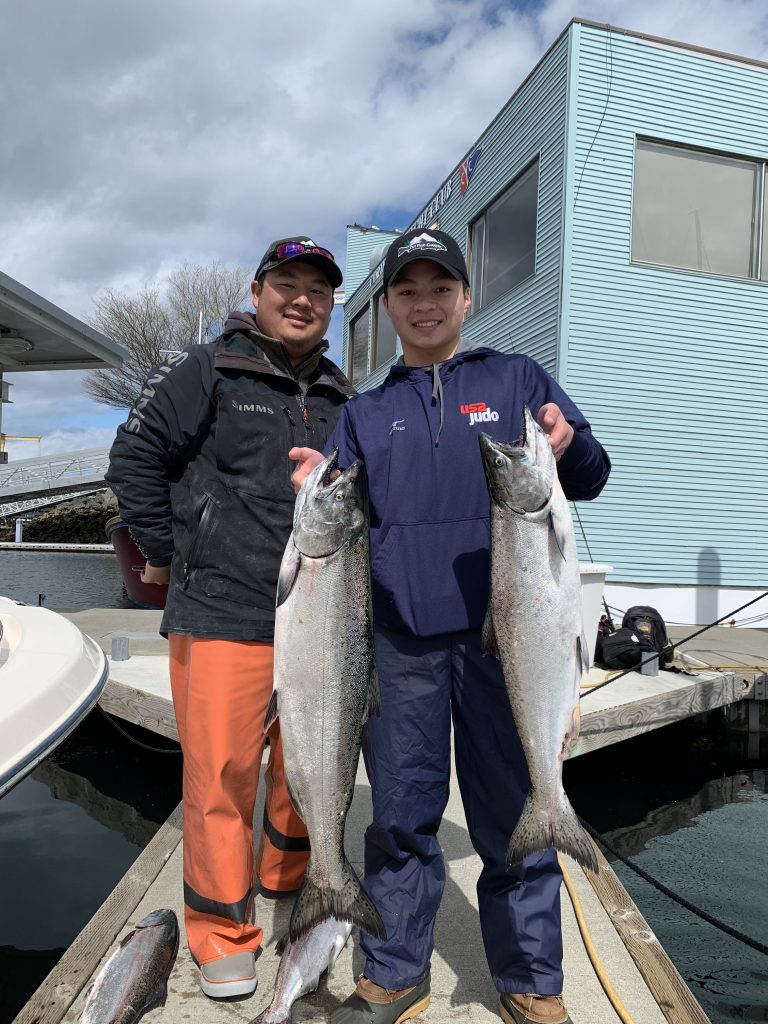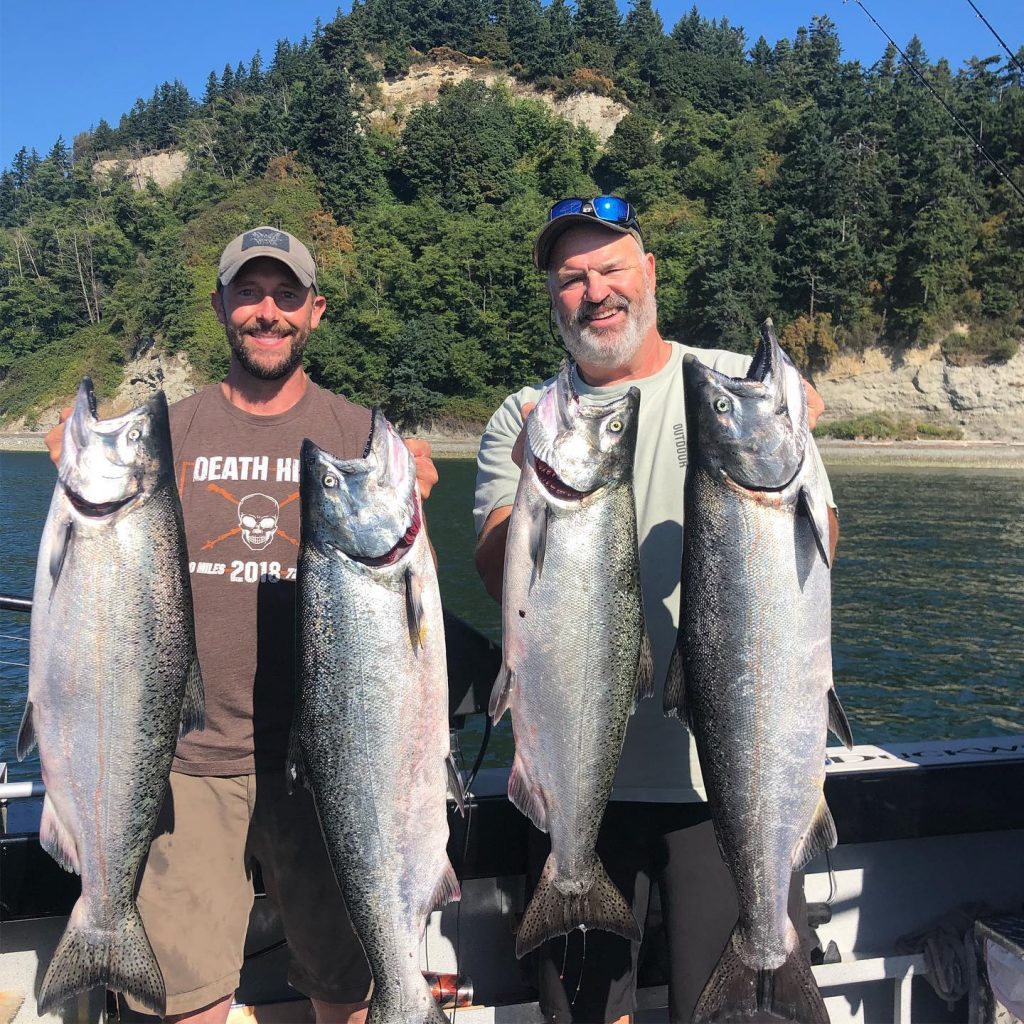After a “hot” start the northern Puget Sound king fishery is on a more normal catch pattern and will remain open for foreseeable future, plus Neah Bay chinook limit to be reduced soon Leave a reply

By Mark Yuasa
After coming out of the starting gate hot this past weekend, it appears the northern Puget Sound (Area 9) hatchery chinook fishery will remain open for now, according to the Washington Department of Fish and Wildlife (WDFW) staff.
At the Puget Sound sport-fishing advisory group meeting this afternoon, the WDFW staff indicated the Area 9 catch showed 1,654 of the 4,700-hatchery chinook harvest quota (35 percent total) had been caught through Monday, July 19.
The catch ratio was one chinook per rod early in the day on Friday, July 16 opener with the highest percentage coming from the Port Townsend Boat Haven Marina launch site. Other places like the Everett ramp showed 192 boats with 451 anglers July 16 caught 158 chinook, 48 coho and one pink for a 0.35 chinook per rod average.
“Fishing started off very hot on the opener, but in the past few days it has slowed down,” said Paul Kim, owner of Seattle Squid charter service in Seattle (https://www.facebook.com/SeattleSquid/), who fished Midchannel Bank off Port Townsend on Monday (July 19) and hooked two kings.

The central Puget Sound (Area 10) chinook opener is following a historical catch pattern. Through Monday, July 19, the estimated catch was 184 of the 3,718-hatchery chinook harvest quota (5 percent).
Fishing for chinook and coho has been fair at best although some continue to score a decent number of fish off Midchannel Bank at Port Townsend, Point No Point, Double Bluff off south side of Whidbey Island, Possession Bar, Pilot Point, Kingston, Richmond Beach to the Edmonds Oil Dock, and off Edmonds Marina breakwater. Jefferson Head has been spotty and an outbreak of jellyfish getting on fishing lines has made it a tough to fish.
In south-central Puget Sound (Area 11), an estimated 744 of the 3,084-hatchery chinook quota (24 percent) has been caught through Monday, July 19. The sub-legal encounter rate is 766 of the allowable 4,233 ceiling (18 percent) and the unmarked “wild chinook” encounter rate is 421 of the 1,586 ceiling (27 percent).
The catch since the July 1 opener in Area 11 has remained steady although there have been dips in success and recently started to see improvements.
The Tulalip Bubble Terminal Salmon Fishery and freshwater areas of Snohomish River system basin closed on July 16 until further notice after WDFW along with co-managers increased the chinook broodstock objectives in 202 to 8.5-million egg-take for hatchery programs.
Actual returns so far this season have fallen short at places like the Bernie Gobin Hatchery. Once the broodstock goal is achieved WDFW could reopen the terminal fishery.
Catch rates in the open section of the Skykomish River for sport anglers was much better than expected with an estimated catch of 500 hatchery chinook, which was an improvement compared to last year.
Through July 16, the bubble sport fishery catch before it closed was 1,360 hatchery chinook compared to season totals of 3,416 in 2020; 4,421 in 2019; 6,644 in 2018; 9,216 in 2017; 4,810 in 2016; 1,891 in 2015; 1,207 in 2014; 636 in 2013; and 319 in 2012.
Both tribal catches and recruitment to hatchery facilities falling below expectations this season. The tribal fishing season is also closed until further notice.

In other salmon fisheries, based on initial catch estimates through Monday, July 19, WDFW indicates Sekiu (Area 5) in the western Strait of Juan de Fuca is at 92 percent of the legal-size chinook encounters (6,937 out of 7,565). The sub-legal encounter rate is 6,830 of the allowable 17,041 ceiling (40 percent) and the unmarked “wild chinook” encounter rate is 5,886 of the 11,401 ceiling (52 percent).
The chinook fishery in open areas of the east Strait around Port Angeles and Freshwater Bay remains open. Based on initial catch estimates through Monday, July 19, WDFW indicates they’re at 30 percent of the legal-size chinook encounters (2,085 out of 6,843). The sub-legal encounter rate is 944 of the allowable 3,573 ceiling (26 percent) and the unmarked “wild chinook” encounter rate is 903 of the 2,158 ceiling (42 percent).
After just a week of chinook fishing after opening on July 1, the San Juan Islands (Area 7) remains closed to all salmon fishing. Through July 7, WDFW indicates Area 7 is at 185 percent of the legal-size chinook encounters (2,550 out of 1,382). The sub-legal encounter rate is 983 of the allowable 1,899 ceiling (52 percent) and the unmarked “wild chinook” encounter rate is 1,274 of the 2,466 ceiling (52 percent). WDFW is currently assessing whether the bubble fishery area can reopen later in the season for pinks and hatchery coho.
Along the northern coast, WDFW has decided to reduce the chinook daily catch limit from two to one at Neah Bay beginning this Saturday (July 24). This will likely extend the ocean Area 4 sport fishing season now that the Sekiu area has closed for chinook and there was an expected shift in effort.

